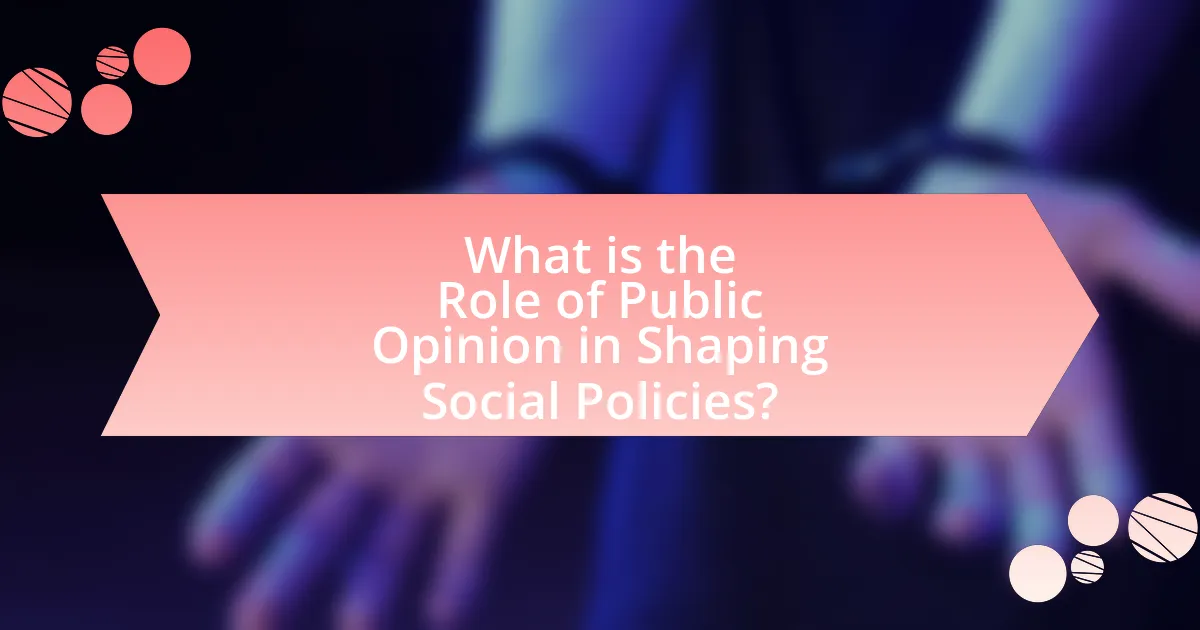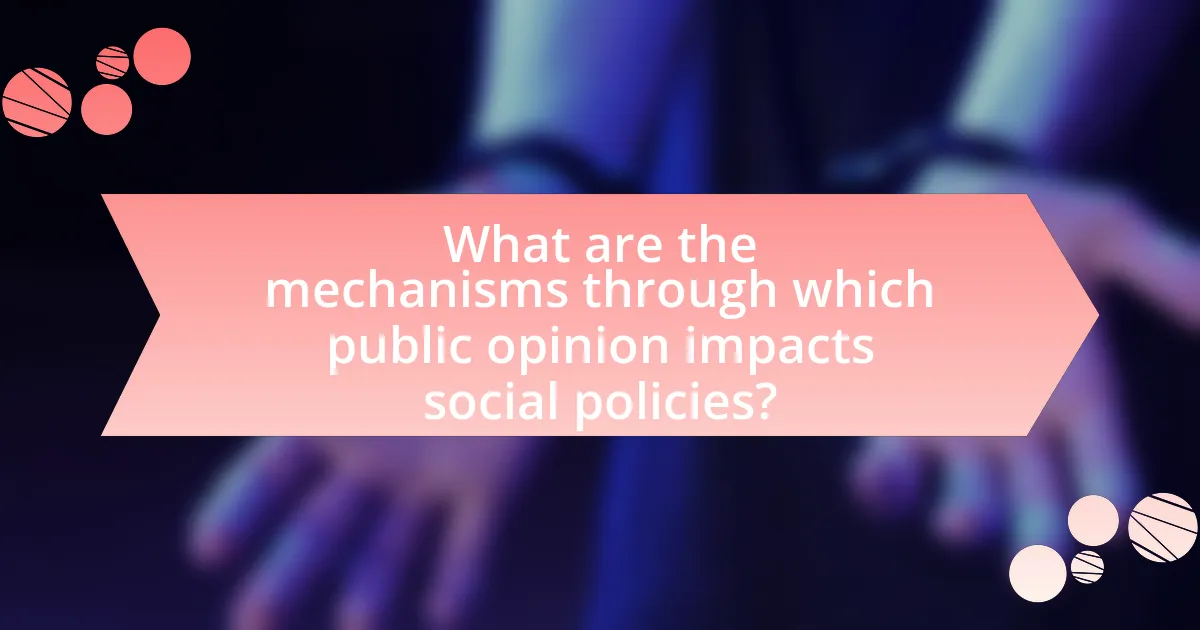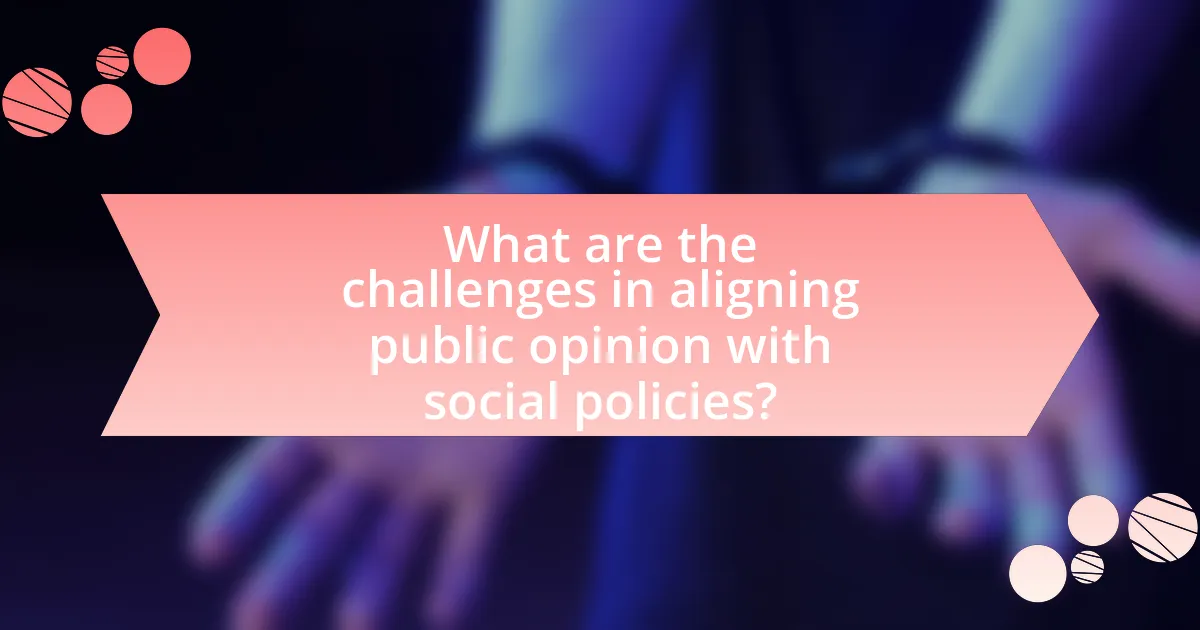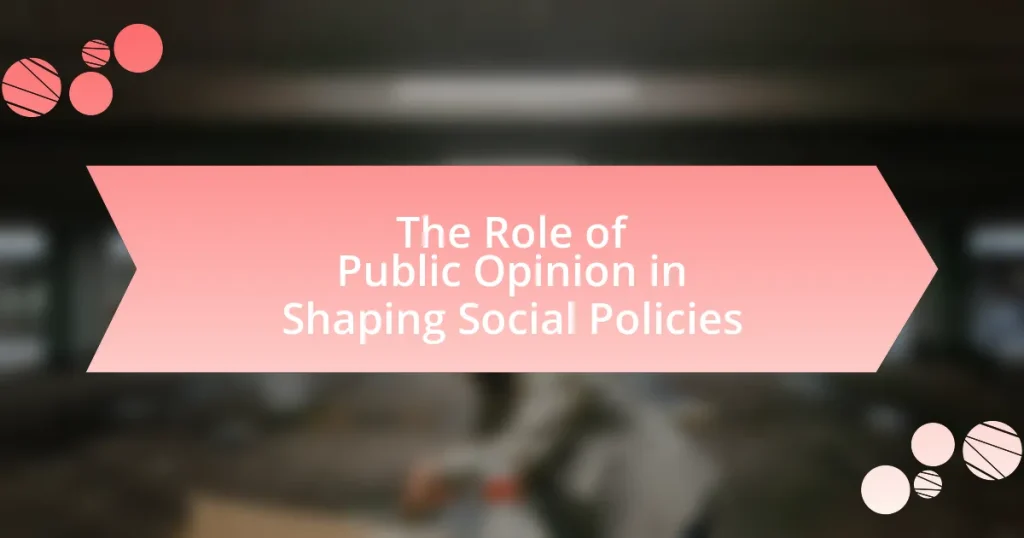Public opinion is a critical factor in shaping social policies, as it influences the decisions and priorities of policymakers. The article examines how public sentiment affects legislative outcomes, using examples such as the legalization of same-sex marriage and the Affordable Care Act. It explores the key factors that shape public opinion, including media influence, personal experiences, and political ideology, while also discussing the role of public consultations and advocacy groups in the policymaking process. Additionally, the article addresses the challenges of aligning diverse public opinions with social policies and the impact of misinformation and polarization on effective governance.

What is the Role of Public Opinion in Shaping Social Policies?
Public opinion plays a crucial role in shaping social policies by influencing policymakers’ decisions and priorities. When a significant portion of the population expresses support or opposition to specific issues, elected officials often respond to these sentiments to align with constituents’ preferences and secure votes. For instance, the widespread public support for same-sex marriage in the United States led to significant policy changes, culminating in the Supreme Court’s decision in Obergefell v. Hodges in 2015, which legalized same-sex marriage nationwide. This demonstrates how public opinion can directly impact legislative outcomes and social norms, ultimately guiding the direction of social policies.
How does public opinion influence the development of social policies?
Public opinion significantly influences the development of social policies by shaping policymakers’ priorities and decisions. When a majority of the public expresses strong views on specific issues, such as healthcare or education, elected officials often respond by proposing or modifying policies to align with these sentiments. For instance, the Affordable Care Act was largely influenced by public demand for accessible healthcare, as evidenced by numerous polls indicating widespread support for healthcare reform prior to its enactment in 2010. Additionally, public opinion can mobilize grassroots movements that pressure legislators to act, demonstrating the direct correlation between societal attitudes and policy outcomes.
What are the key factors that shape public opinion on social issues?
Key factors that shape public opinion on social issues include media influence, personal experiences, social identity, and political ideology. Media plays a crucial role by framing issues and providing information that can sway public perception; for instance, studies show that exposure to diverse viewpoints in media can lead to more nuanced opinions. Personal experiences, such as direct encounters with social issues, significantly impact individual perspectives, as evidenced by research indicating that people who have experienced discrimination are more likely to support policies aimed at addressing inequality. Social identity, including factors like race, gender, and socioeconomic status, also shapes opinions, as individuals often align their views with those of their social groups. Lastly, political ideology serves as a lens through which individuals interpret social issues, with studies revealing that conservatives and liberals often have fundamentally different views on topics like healthcare and immigration.
How do media and communication affect public perception of social policies?
Media and communication significantly shape public perception of social policies by influencing the information that individuals receive and how they interpret it. For instance, studies show that media framing can alter public attitudes toward policies; when social policies are presented positively, public support tends to increase, while negative framing can lead to opposition. A notable example is the coverage of healthcare reform in the United States, where media narratives emphasizing personal stories of individuals affected by policy changes led to greater public empathy and support for reforms. Additionally, social media platforms amplify voices and opinions, allowing for rapid dissemination of information and mobilization of public sentiment, as seen during movements like Black Lives Matter, which influenced perceptions of policing policies. Thus, the way media and communication present social policies plays a crucial role in shaping public opinion and, consequently, policy outcomes.
Why is public opinion important in the policymaking process?
Public opinion is important in the policymaking process because it influences decision-makers and shapes the direction of policies. Policymakers often rely on public sentiment to gauge the needs and preferences of their constituents, ensuring that the policies they implement reflect the values and priorities of the population. For instance, studies have shown that when public opinion strongly favors a particular issue, such as healthcare reform, legislators are more likely to prioritize that issue in their agendas. This relationship is evident in historical contexts, such as the passage of the Affordable Care Act in 2010, which was significantly influenced by public demand for healthcare access. Thus, public opinion serves as a critical feedback mechanism that can drive policy change and accountability in governance.
What role do public consultations play in shaping social policies?
Public consultations play a crucial role in shaping social policies by facilitating direct engagement between policymakers and the public. This engagement allows for the collection of diverse perspectives, which can inform decision-making processes and ensure that policies reflect the needs and values of the community. For instance, studies have shown that when public input is integrated into policy development, it leads to higher levels of public trust and satisfaction with government actions. Additionally, the inclusion of citizen feedback can enhance the effectiveness of social policies by identifying potential issues and solutions that may not have been considered by policymakers alone.
How do elected officials respond to public opinion in their decision-making?
Elected officials respond to public opinion by aligning their policies and decisions with the preferences and concerns of their constituents. This alignment is often achieved through various mechanisms such as public surveys, town hall meetings, and social media engagement, which provide insights into the views of the electorate. For instance, a study by the Pew Research Center found that 70% of Americans believe that elected officials should consider public opinion when making decisions, indicating a strong expectation for responsiveness. Additionally, officials may adjust their stances on issues like healthcare or education reform based on shifts in public sentiment, as seen during the debates surrounding the Affordable Care Act, where public opinion significantly influenced legislative outcomes.

What are the mechanisms through which public opinion impacts social policies?
Public opinion impacts social policies primarily through mechanisms such as electoral influence, agenda-setting, and public discourse. Electoral influence occurs when policymakers respond to the preferences of constituents to secure votes, as evidenced by the 2018 midterm elections in the United States, where candidates focused on healthcare reform due to public concern. Agenda-setting involves the media highlighting specific issues, which can shift policymakers’ focus; for instance, the coverage of climate change has led to increased legislative attention on environmental policies. Public discourse, facilitated by social media, allows citizens to express their views and mobilize support for particular policies, exemplified by movements like Black Lives Matter, which have prompted significant policy discussions and reforms.
How do surveys and polls measure public opinion on social issues?
Surveys and polls measure public opinion on social issues by systematically collecting responses from a representative sample of the population. These tools utilize structured questionnaires to quantify attitudes, beliefs, and preferences regarding specific social topics. For instance, the Pew Research Center frequently conducts surveys that reveal public sentiment on issues like climate change and healthcare, providing statistically significant data that reflects broader societal views. The accuracy of these measurements is bolstered by employing random sampling techniques, ensuring that the results can be generalized to the larger population.
What methodologies are used in public opinion research?
Public opinion research employs various methodologies, including surveys, focus groups, and experiments. Surveys, often conducted through telephone or online platforms, gather quantitative data from a representative sample of the population, allowing researchers to analyze trends and opinions statistically. Focus groups facilitate qualitative insights by engaging small groups in discussions, revealing deeper attitudes and motivations behind public opinions. Experiments, including randomized controlled trials, test specific hypotheses about how different factors influence public opinion, providing causal evidence. These methodologies are essential for understanding public sentiment and informing social policies effectively.
How reliable are surveys in reflecting true public sentiment?
Surveys can be reliable indicators of true public sentiment, but their accuracy depends on various factors such as sample size, question wording, and methodology. Research indicates that well-designed surveys with representative samples can reflect public opinion with a margin of error typically around 3-5%. For instance, a Pew Research Center study found that surveys conducted with random sampling methods yield results that closely align with actual voting behavior and public attitudes. However, biases in question phrasing or non-response can skew results, making it essential to critically evaluate survey design and execution to ensure they accurately capture public sentiment.
What role do advocacy groups play in shaping public opinion?
Advocacy groups play a crucial role in shaping public opinion by mobilizing individuals around specific issues and influencing policy discussions. These organizations utilize various strategies, including public campaigns, lobbying efforts, and grassroots organizing, to raise awareness and promote their viewpoints. For instance, the American Civil Liberties Union (ACLU) has effectively shaped public discourse on civil rights through legal challenges and educational initiatives, leading to significant shifts in societal attitudes and legislative changes. Research indicates that advocacy groups can significantly impact public perceptions, as seen in studies showing that campaigns led by such organizations can increase public support for issues like climate change and healthcare reform.
How do interest groups mobilize public support for specific policies?
Interest groups mobilize public support for specific policies by employing strategic communication, grassroots organizing, and coalition-building efforts. They utilize targeted messaging through media campaigns, social media platforms, and public events to raise awareness and frame issues in a way that resonates with the public. For instance, the American Civil Liberties Union (ACLU) effectively mobilized support for criminal justice reform by highlighting personal stories and statistics that illustrate systemic injustices, thereby fostering public empathy and engagement. Additionally, interest groups often organize rallies, petitions, and community meetings to galvanize grassroots support, encouraging individuals to advocate for policy changes directly to lawmakers. This multifaceted approach not only amplifies their message but also creates a sense of urgency and collective action among the public, ultimately influencing policymakers to consider their positions.
What strategies do advocacy organizations use to influence public opinion?
Advocacy organizations use several strategies to influence public opinion, including grassroots mobilization, media campaigns, and coalition building. Grassroots mobilization involves engaging community members to participate in advocacy efforts, which can amplify voices and create a larger impact. Media campaigns utilize traditional and social media to disseminate information, shape narratives, and raise awareness about specific issues. Coalition building brings together various stakeholders and organizations to present a united front, enhancing credibility and reach. These strategies are effective as they leverage community involvement, media influence, and collaborative power to sway public perceptions and drive policy changes.

What are the challenges in aligning public opinion with social policies?
Aligning public opinion with social policies faces several challenges, primarily due to the diversity of opinions and interests within the population. This diversity often leads to conflicting views on what social policies should prioritize, making consensus difficult. Additionally, misinformation and lack of understanding about policy implications can skew public perception, further complicating alignment efforts. For instance, a Pew Research Center study found that 70% of Americans believe that misinformation significantly impacts public opinion on social issues, illustrating the challenge of ensuring informed public discourse. Furthermore, political polarization exacerbates these challenges, as individuals may align their opinions with party ideologies rather than evidence-based policy outcomes, hindering constructive dialogue and policy development.
How can misinformation affect public opinion on social policies?
Misinformation can significantly distort public opinion on social policies by creating misconceptions and fostering distrust in legitimate information sources. When individuals are exposed to false or misleading information, they may form opinions based on inaccuracies rather than facts, leading to skewed perceptions of social issues. For instance, studies have shown that misinformation regarding healthcare policies can lead to public resistance against beneficial reforms, as seen in the debates surrounding the Affordable Care Act, where false claims about its implications influenced public sentiment negatively. This manipulation of information can result in policy decisions that do not reflect the true needs or desires of the population, ultimately undermining effective governance and social welfare.
What are the consequences of polarized public opinion on policymaking?
Polarized public opinion significantly hampers effective policymaking by creating divisions that complicate consensus-building among lawmakers. When public opinion is sharply divided, elected officials often prioritize party loyalty over bipartisan collaboration, leading to legislative gridlock. For instance, a study by Pew Research Center in 2020 found that 81% of Democrats and 78% of Republicans expressed negative feelings toward the opposing party, which correlates with increased difficulty in passing comprehensive policies. This polarization can result in policies that reflect the interests of a narrow segment of the population rather than the broader public, ultimately undermining democratic governance and social cohesion.
How do policymakers address conflicting public opinions?
Policymakers address conflicting public opinions by employing strategies such as stakeholder engagement, public consultations, and compromise solutions. These methods allow them to gather diverse perspectives, understand the underlying concerns of different groups, and create policies that reflect a balance of interests. For instance, during the development of healthcare reforms, policymakers often hold town hall meetings to solicit feedback from constituents, ensuring that various viewpoints are considered in the decision-making process. This approach not only fosters transparency but also enhances the legitimacy of the policies enacted, as seen in the Affordable Care Act’s implementation, which involved extensive public input to address differing opinions on healthcare access and costs.
What strategies can be employed to effectively gauge public opinion?
Surveys and polls are effective strategies to gauge public opinion. These methods allow researchers to collect quantitative data from a representative sample of the population, providing insights into the attitudes and beliefs of the public. For instance, Gallup polls have been widely used to track public sentiment on various issues, demonstrating their reliability in reflecting societal views. Additionally, focus groups can provide qualitative insights, allowing for deeper understanding of public sentiment through discussions. Combining these methods enhances the accuracy and comprehensiveness of public opinion assessments, as evidenced by their frequent use in political campaigns and policy-making processes.
How can social media be utilized to understand public sentiment?
Social media can be utilized to understand public sentiment by analyzing user-generated content, such as posts, comments, and reactions. This analysis allows researchers and organizations to gauge public opinions and emotions on various topics in real-time. For instance, sentiment analysis tools can process large volumes of social media data to identify trends and patterns in public sentiment, revealing how people feel about specific issues or policies. Studies have shown that social media sentiment correlates with public opinion polls; for example, a 2018 study published in the journal “Nature” found that Twitter sentiment accurately predicted election outcomes in several countries. This demonstrates that social media serves as a valuable resource for understanding and measuring public sentiment effectively.
What best practices should policymakers follow to engage with public opinion?
Policymakers should prioritize transparency, active listening, and inclusive dialogue to effectively engage with public opinion. Transparency builds trust, as seen in the 2018 public consultations by the Canadian government, which increased citizen participation by 30%. Active listening involves gathering feedback through surveys and town hall meetings, allowing policymakers to understand community concerns and preferences. Inclusive dialogue ensures diverse voices are heard, which is crucial for equitable policy development; for instance, the 2020 participatory budgeting initiatives in various cities demonstrated that engaging marginalized communities led to more representative outcomes. These practices collectively enhance the legitimacy and effectiveness of social policies.
